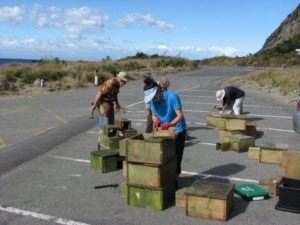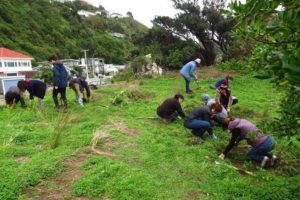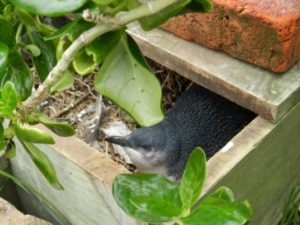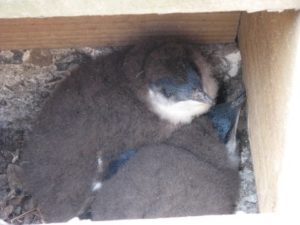For a little penguin (until recently known as little blue penguin) in the city, the urban adventure includes a few extra hazards not encountered by their country-coastline relatives – including large steel-bodied predators super-fuelled by petroleum. If penguins have imaginations, then cars and trucks must seem like living nightmare monsters. But crossing a busy road each night to get to its nest-site is only one of the hazards that an urban or suburban penguin has to cope with.
Fortunately the little penguins (kororā ) of Wellington’s harbour, south coast and Miramar Peninsula have been getting a helping hand for the last few years to enable them to survive and hopefully thrive in our capital city. In 2007, members of the Wellington branch of Forest and Bird formed ‘Places for Penguins’, and are doing what they can to make their harbour city more penguin-friendly.
Peter Hodge, volunteer with Places for Penguins and coordinator of their predator control programme, says there are several things the volunteer group is doing to help their local little penguins. For years they have been involved in habitat restoration work, particularly on the Miramar peninsula. They have also built and monitored the use of nesting boxes, which give the penguins cover to breed and some protection from dogs and seagulls. The nesting boxes are an important aid in the semi-urban environment where the coastline is shared with recreational users and the habitat may be highly modified.
Places for Penguins also works on public awareness, for instance encouraging dog owners using the beaches to have their dog on a lead. They carry out predator control work too – mainly trapping, but some poison-baiting is also done. Peter coordinates a group of about 20-25 people who carry out trapping. While they’re out and about checking traps, they talk with local residents about penguins and other native birds, and the introduced mammals that prey on them, that locals may have seen.
The group has established an extensive trapping network, using a mix of DOC 200, Goodnature A24, and Victor traps. Traps aren’t cheap, says Peter, and there have been problems with traps being vandalised and stolen – another urban hazard which the penguins and their supporters have to deal with.
The little penguins seem to be doing okay in Wellington, Peter says, in part because there are many breeding successfully on Matiu Somes Island, in the middle of Wellington harbour, which is predator-free. On the Miramar Peninsula, nest boxes have been monitored for two seasons and in this, the 3rd season, the group is cautiously optimistic predator control is starting to make a difference, not only for penguins but also for other native birds and insects.
Places for Penguins is currently in a phase of expansion. In the last two years trapping has been ‘ramped up’ with a 200-trap network across the Miramar Peninsula. The trapping group is organised and is keen to expand its volunteer base.
“We have a great group of volunteers, really keen and dedicated, but we’re also ambitious and we need more people to help us achieve our ambitions,” says Peter. This includes people who are keen to take leadership roles, for instance in leading trapping teams. They’d like to help more locals get involved, especially people living along the coast, including through backyard trapping. For people who are keen to help but who don’t have much spare time on their hands, having a trap in the backyard, and keeping track of the kills, is a really practical and useful step, according to the group.
Currently the trapping network is catching mostly rats, with the occasional stoat and weasel, along with “quite a few hedgehogs and mice”, Peter says. The group’s control strategy is threefold. Sites where penguins are known to be breeding or there is good habitat are targeted with localised control around nest boxes, using Goodnature A24s. In the surrounding areas, the focus is on intensive trapping and baiting, while along nearby shorelines, DOC 200 traps are used to control mustelids, especially stoats, from moving into the penguin breeding areas.
The group is carrying out intensive control on the south and north coasts of the Miramar Peninsula and hopes to extend the trapping programme to every bay around the Peninsula, perhaps over a 3-5 year timeframe. In the longer term, with new technologies and approaches, such as backyard trapping, Peter says it may be possible to make the whole of Miramar Peninsula predator-free, and to extend predator control to other areas where little penguins breed around the Wellington coastline. Like other groups, the challenge for Places for Penguins is to scale up local predator-control to the bigger landscape, and maintain that effort, for a decisive impact, Peter says.
A key part of the ability to scale up is conservation groups working together, and with councils, technology companies and philanthropists, to share ideas and expertise, and to coordinate their efforts across regions. For one thing, Peter’s keen to see more forums where groups can make contact with each other to share ideas and technical assistance. It’s a vision that we at PFNZ heartily share.





